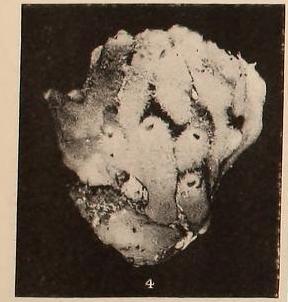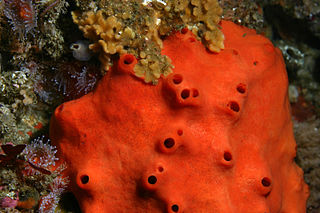
Hexactinellid sponges are sponges with a skeleton made of four- and/or six-pointed siliceous spicules, often referred to as glass sponges. They are usually classified along with other sponges in the phylum Porifera, but some researchers consider them sufficiently distinct to deserve their own phylum, Symplasma. Some experts believe glass sponges are the longest-lived animals on earth; these scientists tentatively estimate a maximum age of up to 15,000 years.

Minchinellidae is a family of calcareous sponges, members of the class Calcarea. It is the only family in the monotypic order Lithonida. The families Petrobionidae and Lepidoleuconidae have also sometimes been placed within Lithonida, though more recently they have been moved to the order Baerida. Thanks to their hypercalcified structure, minchinellids have a fossil record reaching as far back as the Jurassic Period.

Sponge reefs are reefs produced by sea sponges. All modern sponge reefs are formed by hexactinellid sponges, which have an endoskeleton made of silica spicules and are often referred to as "glass sponges", while historically the non-spiculed, calcite-skeletoned archaeocyathid and stromatoporoid sponges were the primary reef-builders.
Clathrina ceylonensis is a species of calcareous sponge from Sri Lanka. The species name is derived from Ceylon, the former name of Sri Lanka.

Clathrina coriacea is a species of calcareous sponge belonging to the class Calcarea and family Clathrinidae. Species in the genus Clathrina are composed of calcium carbonate tube-like skeletons containing spicules. The sponge can be located in shallow waters widely distributed along North Atlantic coasts, as well as on other coasts.
Ascandra izuensis is a species of sea sponge in the family Clathrinidae. The species is named after the Izu peninsula where the holotype was collected.

Spicules are structural elements found in most sponges. The meshing of many spicules serves as the sponge's skeleton and thus it provides structural support and potentially defense against predators.

The orange wall sponge is a species of sea sponge belonging to the order Trachycladida. It is found in the south Atlantic and Indo-Pacific oceans. Around the South African coast, it is known from the Cape Peninsula to Cape Agulhas.
Neopetrosia subtriangularis is a species of marine petrosiid sponges native to the waters off Florida and the Caribbean Sea. They superficially resemble staghorn corals.

Vosmaeropsis mackinnoni is a species of calcareous sponge in the family Heteropiidae, and was first described in 1924 by Arthur Dendy and Leslie M. Frederick. It is known only from its type locality in the Abrolhos Islands, in Western Australia.

Acarnidae is a family of sponges belonging to the order Poecilosclerida. It has a global distribution, although several genera occur primarily in colder temperate waters, and several have very restricted ranges. It is estimated that there are several hundred species.

Coelosphaeridae is a family of sponges belonging to the order Poecilosclerida. Species are found across the globe.
Hamacantha esperoides is a species of demosponge. It is commonly known as the fibrous sponge. It occurs off the southern and western coasts of South Africa, off the coast of Namibia, and off the southeast coast of South America.
Inflatella belli, or the gooseberry sponge, is a species of demosponge that appears to be restricted to the southern hemisphere, where it is widespread. It occurs from the coast of Namibia and the Indo-pacific, down to the Subantarctic and Antarctic regions.
Mycale anisochela, the brain sponge, is a species of demosponge from South Africa and Namibia.
Polymastia bouryesnaultae, the knobbly sponge, is a small and cryptic species of demosponge from South Africa and Namibia.
Suberites dandelenae, the amorphous solid sponge, is a species of deep-sea demosponge from South Africa and Namibia.
Penares sphaera, the crater sponge, is a deep sea demosponge from southern Africa.
Tetilla casula, the volcano sponge, is a species of demosponge from the south coast of South Africa.
Rossella antarctica is a relatively small species of glass sponge. It is widely distributed in the southern hemisphere, particularly in the Antarctic and sub-Antarctic regions.







